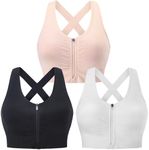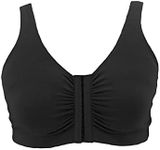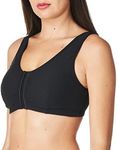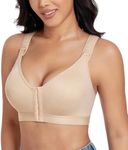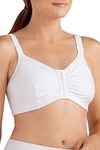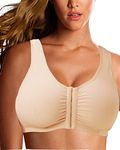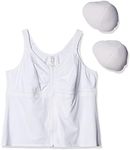Buying Guide for the Best Post Op Bras
Choosing the right post-op bra is essential for comfort, healing, and support after breast surgery. Whether you've had a mastectomy, augmentation, reduction, or reconstruction, the right bra can help reduce swelling, protect incisions, and provide gentle compression. It's important to focus on features that promote healing and comfort, rather than style or appearance. Always follow your surgeon's recommendations, but understanding the key features will help you make an informed choice that suits your recovery needs.Compression LevelCompression level refers to how tightly the bra holds your chest. This is important because the right amount of compression can help reduce swelling, support healing tissues, and prevent fluid buildup. Compression bras usually come in light, moderate, or firm levels. Light compression is gentle and suitable for those with minor swelling or sensitivity, moderate is the most common and balances comfort with support, while firm compression is used when more control is needed, such as after certain surgeries. Your doctor will often recommend the right level, but if you are choosing yourself, consider how much swelling you have and how sensitive your skin feels.
Closure TypeClosure type describes how the bra is fastened, such as front-closure, back-closure, or pullover. This matters because after surgery, you may have limited arm movement or tenderness, making some closures easier to manage than others. Front-closure bras are the most popular for post-op use because they are easy to put on and take off without raising your arms. Back-closure bras can be difficult to manage after surgery, and pullover styles are usually not recommended unless you have full mobility. Choose a closure type that you can handle comfortably during your recovery.
Material and SeamsThe material and seams of a post-op bra affect comfort and skin health. Soft, breathable, and hypoallergenic fabrics like cotton or bamboo are best because they reduce irritation and allow your skin to breathe. Seams should be flat or minimal to avoid rubbing against sensitive areas or incisions. Some bras are labeled as 'seamless' for extra comfort. If you have sensitive skin or healing incisions, prioritize bras with gentle materials and minimal seams.
AdjustabilityAdjustability refers to features like adjustable straps or multiple hook positions that let you change the fit of the bra. This is important because your body may change shape as swelling goes down, and you may need a tighter or looser fit over time. Adjustable bras allow you to customize support and comfort as you heal. If you expect changes in swelling or want a bra that adapts to your needs, look for adjustable features.
Support and Band WidthSupport and band width describe how well the bra holds your chest and how wide the band is under your bust. Good support is crucial for healing and comfort, while a wider band helps distribute pressure evenly and prevents the bra from digging into your skin. If you have larger breasts or have had extensive surgery, a bra with strong support and a wide band is usually best. For smaller breasts or less invasive procedures, lighter support and a narrower band may be enough.
Pocketed DesignA pocketed design means the bra has built-in pockets to hold breast forms or prostheses. This is especially important for those who have had a mastectomy or lumpectomy and want to use a prosthesis for balance or appearance. If you need to wear a breast form, make sure the bra has secure, comfortable pockets. If you don't need a prosthesis, this feature may not be necessary.
